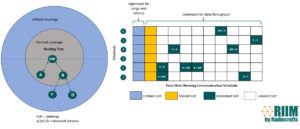Costly damage is inflicted on solar energy installations by high wind and hailstorm conditions. Solar trackers mitigate this problem by moving into safe/stow position upon a critical weather event. The time it takes to enter safe/stow position is becoming an important metric when comparing the competitiveness of different tracker solutions. Also, the extent to which all trackers reliably enter safe/stow position is critical.
Radiocrafts, being a leader in solar tracker radio control, has tailored our RIIM sub-GHz mesh solution to ensure that we support both the lowest latency and the highest reliability for control in the face of critical weather events. In the upcoming release we introduce a new feature drastically reducing the time it takes to distribute the safe position.
Because Radiocrafts Industrial IP mesh (RIIM) is based on TSCH (Time Slotted Channel Hopping), the customer can do radio magic not feasible with technologies such as Wi-SUN. TSCH gives you not only ultra-reliable communication, but also adds the ability to have different data-rates in your timeslots. The reason that RIIM can do this is the unified synchronization over the entire network, ensuring a common understanding of when to do long range mode and when to use high data rate mode. Utilizing this gives the best of two worlds; high data rate for tracker data reporting combined with low latency for safe/stow broadcast. The result is a radio protocol with high uplink and downlink data capacity that also can ensure safe/stow position in less than one second.
With the tight time synchronization of RIIM, if one node knows the time of day, then all nodes know the time of day with < 10ms accuracy. This allows each tracker to log the safe position events with high accuracy for later investigation.
Whenever we need to quickly send a critical alarm or event to all trackers, RIIM uses a long-range mode, offering less data throughput than normal. This allows the message to reach all trackers without the need for mesh-based multicast, something which cannot be done without introducing latency from the routing and forwarding.
![]()
Reach out and get a Development Kit to start testing this state-of-the art mechanism, crucial for a long lasting and reliable solar tracking installation!
You can also download our Wireless Technologies Selection Guide For Solar Tracking to learn more about wireless communication options available in the market today (ex: LoRa, Wi-SUN, ZigBee) and their performance factors for Solar Tracking Installations against RIIM!


